59: Owen Jones (1809-74) and De La Rue
A selection of examples of Owen Jones's artwork printed by De La Rue.
MY NEW BOOK ON OWEN JONES'S BACK DESIGNS IS NOW AVAILABLE. SEE MY HOME PAGE (ABOUT KEN LODGE) FOR DETAILS. I HAVE ALSO PRODUCED A CHECKLIST OF ALL THE IDENTIFIED NUMBERED DE LA RUE BACK DESIGNS FROM 1844 TO THE END OF THE 19TH CENTURY, AVAILABLE FROM ME AT k.lodge111@btinternet.com, COSTING £20 + POSTAGE.
Back in 2006 Mike Cooper and I published an article on Owen Jones with quite a number of illustrations. There are also further illustrations on page 5 of this blog and in my most recent book: The British playing card industry 1600-2000. There is no need to repeat all that information here, but it might be useful to consider in more detail which back designs are definitely by Jones. Because a lot of new material has come to light since I first started this page, it's time to rewrite it to include the information that is now available. This may tale a little while, so you may find inconsistencies in the text, as I revise it in stages. We now have access to many of Jones's original sketches for the back designs which are housed in a university library in Nashville, Texas. I managed to track them down with the help of the United States Playing Card Co. They are contained in a book from the Clulow collection that was bought by that company in 1898. In the light of this new material I have revised the pages attached to this page, as many of the hitherto unidentified designs now have a design number. It is also clear that there are two sets of numbers to deal with: the design numbers, which I have prefixed with a D- and those used by De La Rue in their sales material (stock numbers, prefix S-). In some cases we have both for the same design. For a letter referring to this purchase, see further below. Until recently, further material from the De La Rue archive sold in 1970 was held in private hands and hasn't been available for investigation. Now some of it has resurfaced thanks to Victoria Braojos Nieves, who runs a museum in Madrid dedicated to tarot and playing cards. The albums are 3, 5, 6, 7, 11, 13, 14, and three stock books with commentaries as to dates of use, series (e.g. Figured Moguls, Racers) and in some cases dates of destruction of the plates/stones. The material was available online through the auction house, as it was auctioned on 23 May 2023. Some of the designs are specifically marked as by Jones, but he also had co-workers, who are identified only by initials on the backs of some designs. It should be noted that the vast majority of the examples from the former archive are the pre-production prints, rather than sample cards. The last design number in the sketch book is D544, but one or two of the designs in the pre-print albums are identified as by Jones. It's also the case that some of his designs were held back for future use, so that some were used after his death in 1874. For example, the design called Byzantine (D399) was produced by Jones in 1870, but it wasn't used until the 1882-83 season with the stock number S574. The preprint version is in Album 5 with Jones's dated signature on the back and a note regarding the year of use. It is found in the Silber & Fleming catalogue of the early 1880s as a sample card with its stock number.

D399 Byzantine
Stock numbers are usually lower than the design number, but where they aren't, it indicated a later use of the design or its reintroduction into the catalogue.
We need to see the designs in the context of Jones's major work The grammar of ornament, published first in 1856. For the most part, this is not the source of the designs he made for De La Rue, but it is the inspiration. The grammar is a collection of actual decorative motifs from all over the world, put together in an attempt to lay the foundations of all ornamentation in the Victorian period. He uses the word grammar to refer to the basic component parts from which decoration can be fashioned and hopes to have captured all there is to capture in actual examples. There are a few actual examples from the grammar to be found on the backs of cards. Strangely, some of them are fairly uninspiring. For example, there is an all-over one that is used in cheap packs, e.g. Andrews, which comes from China and is taken from decorative porcelain. So, this is not a design by Jones, but one taken from his source book. Later it was turned through 90º and produced in various colours.

Above: Chinese porcelain decoration from Plate LIX (green in the Grammar)
On the other hand, one particular design is taken directly from an Indian book cover with a few changes, illustrated in the Grammar as Plate LIV: S156 Indian Rose. I have no D-number for this design, but as it came from the Grammar, it may not have had one.

Above: Plate LIV / S156 Indian Rose.
An example that was drawn by Jones comes from the final section of the Grammar in which he exemplifies leaves and flowers from nature in black and white outline on a buff ground (except for Plate XCVIII, which is in full colour). In this case the subject is a rose branch with hips. Again it was used in relatively cheap packs, as it has an all-over colour background. I have seen a copy of this in a Belgian pack imported into this country by Alfred Davis.


Above: Rose-hips from Plate XCVI, still available in 1880.
A mark of the popularity of Jones's designs, even abroad, can be seen in the pack by Dougherty with odd courts from the 1850s with a back copied closely from a De La Rue one of the same period. The impressions are not from the same plates, but the closeness is remarkable. (Dougherty also copied De La Rue's D3 single-figure courts; see page 42►)

Above: D4, 1850-55

Above: Dougherty, copy of Jones design, 1850s
One can assume that these drawings from nature were the basis for his early designs from the 1840s and 1850s, which were similar botanical drawings. Some of them continued in use in cheaper packs into the 1870s and beyond. The violet design was particularly popular.

Above: Trade samples from the 1850s; the small card top left exemplifies the Victoria format, though this design continued in use on full-size cards until the 1880s.
The style of his plant drawings then changed and more detail and three-dimensionality is discernible. These designs seem to belong to the post-Frizzle period.

It isn't entirely clear whether Jones was the only designer employed during the 1840s and 1850s, so we can't be sure whether any of the following, which are all from the 1850s, are by him:

Above: 9 designs which cannot definitely be attributed to Owen Jones, though some/all of them may be.
The design below from a pack with D4.1 courts and Old Frizzle dating from 1855-62 may also be by Jones, even though he didn't usually use representations of the human or animal form in any of his work, but in this case and a few others the human-like forms are part of the design, rather than the focus of the representation.

There is a list of Jones's designs produced between 1844 and 1863: it's a hand-written note dated 1868 in the De La Rue archives. Unfortunately, the list gives little detailed information about the designs, using mostly generic descriptions, such as 'Pompeian' and 'floral', but it does give an idea of when the designs were originally made. The dates given in the list aren't necessarily the dates De La Rue used them as back designs. For example, some of the designs dated 1863 were not issued until 1867, which we know from an advertisement in The Stationer & Fancy Trades Register, where nos. 157, 163, 169 and 171 are illustrated as new additions to the season's offerings. Given what I said about the two different number series, it would appear the numbers in the list are design numbers. The list is as below:

Interestingly, the first numbered design in the pre-print albums is D174; in the sketch book it is D175.
The late Mike Goodall kindly sent me a copy of a letter that refers to some 500 designs by Jones in a book from the Clulow collection. (In fact there are about 350 designs.) This book, along with the rest of the USPCC collection, is now housed in the Jean and Alexander Heard Library of Vanderbilt University in Nashville. It contains the original pencil sketches of Jones, some of which are identifiable card backs and others are small pieces of decoration that could be used in back designs. These designs are now digitized and are available online on the academic JSTOR platform. I recently came across evidence that USPCC used at least a few of Jones's designs in their own cards from c.1900-1920, as I have two examples of design number D577 by them in wide size and a revised version for the whist-size cards. In addition, I have a bridge-size, double-ended revision of one of the floral designs numbered D382 in the Clulow material.


D577 by the USPCC plus one revised version and a double-ended version of D382

If we have the reference number in an actual catalogue of samples, we can tell which design is meant, but sample books don't seem to have come in until the 1860s. It is also clear that there are later designs by Jones beyond the 173 of the hand-written list, as evidenced by the sketch book. We must remember, however, that in the 1868-69 catalogue the numbers are the stock numbers. In The Stationer & Fancy Trades Register of January 1870 further designs appear with stock numbers in the 200s. And now we have definite evidence that Jones was working on designs up until his death in 1874 and that many of the designs were used well after his death. It should also be noted that there was often a time-lag between the initial design by Jones and its implementation in the De La Rue catalogues.

There is a trade list from Silver & Fleming, dated 1880, in the Victoria and Albert Museum, with a long list of De La Rue (and Goodall) cards that they supplied. The designs have two reference numbers: the first four-digit numbers in the list below are those of Silber & Fleming's stock with De La Rue's stock number to the right of the oblique.
No. 8698/514 Indian Pink
No. 8706/207 Indian Jonquil (D324)
No. 8709/158 Prince of Wales
No. 8715/129 Nasturtium
No. 8721/195 White rose (D278)
No. 8723/87 Cotton Plant (D78).
The last of these is dated 1859 in the hand-written list, though it is numbered 78, presumably the design number, but it gives us an idea of how long some of the designs were in use. These designs are listed by Silber & Fleming alongside designs not by Jones, such as S479/D705 Chinese Fisherman, S482 Dovecot and S565/D805 Priestess & Tripod. It is noteworthy that Jones never used animal representations, human or otherwise, in his designs (with the caveat above). The cards on offer in the Silber & Fleming list are unindexed square cornered, round cornered with the patent Dexter indices, and round cornered with what are referred to as "ordinary pips". Whether this is a reference to normal indices or to unindexed cards is not clear, probably the latter.

Above: S479/D705 Chinese Fisherman; S482 Dovecot
The D-numbers come from the pre-print material.
Jones liked to take non-representational designs from the sources in his book producing quite different results. These are often unnamed in the catalogues, but have clearly been influenced by the examples in the Grammar. For instance, there are Pompeian designs dated 1853 in the list, which may not be the same as ones used after 1862; there are four examples below, all of which were still available in 1870. Given the D-numbers, these must date from the late 1860s.

Above: D204/S180 Unnamed

Above: D205/162 unnamed
Interestingly, there are even examples of mediaeval overall designs on the clothing of the single-figure courts (D3) redesigned some time in the 1840s, such as the clover diaper on the QC from Plate LXVIII (no 49) and the decoration on the bottom of the KC's tunic. De La Rue was the first maker to put such detail on the clothing of his courts.

Above: Plate LXVIII (Number 49, second from right, bottom row).

Above: details from D3 QC and KC.
Some designs are taken from a period which itself had copied earlier designs. Some could be Pompeian, mediaeval or Italian in terms of the Grammar. The following is, in fact, described as Italian:

Above: S157 Italian
The following carousel contains the definite examples from the Birmingham sample book of 1868-69; the numbers are stock numbers (click left / right arrows to scroll):
Note that many of the designs came in various colour schemes, as in the example below:

Please note that I omitted to include stock number 137, named Oriental in 1867, in the carousel. It appears below in two colour versions alongside the lily-of-the-valley design.
So, based on all the material I have discussed so far, the list of numbered and/or named designs (some without an illustration) is as follows: 48-51 4 Pompeian; 63 Tartan; 77 Persian; 79; 84*; 87 Cotton Plant; 90*; 119 Indian Corn; 121 Passion Flower; 125 Cineraria; 127 Ripening Olive; 129 Nasturtium; 137 Oriental; 142 Olive Branch; 143-148 6 Chinese; 150 Acorn; 152 Persian Rose; 156 Indian Rose; 157 Italian; 158 Prince of Wales; 160 Indian Feather (in the 1868-69 catalogue the sample card is incorrect, as it's actually the Indian Rose design); 161; 162 (Pompeian); 163 Indian Jewel; 164; 165; 166; 167; 168; 169 Indian Flower; 170 Mille Fleurs; 171 Indian Border; 172; 174*; 175* Peach Blossom; 180 (Pompeian); 181; 182 Indian Frieze; 183 Persian Diamond; 184; 185; 186; 187; 188; 190; 192 Chinese Flowers; 193 Mayflower; 194; 195 White Rose; 196; 200; 202; 204; 205; 206; 207 Indian Jonquil; 210; 211; 213; 214; 219 Fuchsia; 220 Sweet Pea; 223 Princess of Wales. 137 and the numbers from 150 onwards are all stock numbers *with the exception of 84, 90, 174 & 175, which are design numbers. In addition, the following named designs are listed in reviews of De La Rue's cards, the description by Charles Dickens of a trip to the De La Rue factory in 1852, in an advert from 1865 and in an in-house list from 1866, without any illustration: Fuchsia, Cherry Tree, Blue-bell, Forget-me-not, Daisy, Carnation, Ears of Wheat and Barley, Shamrock, Cineraria, Olive, Plum, Pomegranate, Peach, Geranium, Raspberry, Oriental Gold, Willow Pattern. Some of these can be paired with actual examples with some certainty. What we don't know for certain is whether some of the designs kept their names, but underwent stylistic changes. For example, the Geranium design of c.1867 (D303), shown below, can't be the same as the one seen by Charles Dickens in 1852. It was not even the one on the left, because in the new material this is number D420 and dated 1871. Even the simple designs, such as Tartan, have different temporal versions. The ones in the slideshow above from 1868-69 are not the same as the one below from c.1855. In The Stationer and Fancy Trades' Register of July, 1878, there is a specific reference to "combinations and modifications" and "improvements upon old favourites", listing examples such as 381 Indian bouquet and 302 Hindoo rose, which suggests revision and reformulation of earlier designs.

Above: Geranium [D420], left c.1871; [D303] right c.1867.

Above: Tartan, c.1855.
For further and more detailed information and the continuation of designs beyond S223 and D173, download “Owen Jones: his work and his legacy part 1 / part 2 / part 3a / part 3b / part 4 / part 5a / part 5b / part 6 / part 7 / part 8”, a fully illustrated guide to DLR backs from 1844 onwards, which were either by Owen Jones or inspired by him. Parts 4 & 5 deal with colour variants of the identified designs; Part 6 presents those designs for which I only have a stock number. Part 7 is a presentation of the as yet unidentified designs by Jones and his co-workers and Part 8 deals with later designs for mostly round-cornered cards produced well after Jones's death. The dates of the original designs (whether by Owen Jones or not) given in the pre-print material, sometimes with a later date of use by De La Rue, are as follows: 1863: D174-194; 1865: D227-239; 1867: D281-318; 1868: D326-329; 1869: D339-368; 1870: D360, D385-416; 1871: D418-479; 1872: D480-492; 1873: D510-543; 1874: D549-569. In the Clulow material the last page of designs has only two items on it and finishes at D544. Whether Jones produced any further designs before his death in that year is unclear. These pages will be undergoing regular revision, as new material comes to light.
The following selection is of unnamed and unnumbered designs, but are from the 1868-69 catalogue. In the Clulow material some of these do have design numbers. The multicoloured ones are for Moguls and Harrys, whereas the single-coloured ones are for Highlanders.



The top two on the left of the preceding eight examples are design number S137/D192, Oriental.



Finally, here's a selection not all of which are from a catalogue or an advert, but which come from Owen Jones's creative ability; some are from after his death, so may well be by co-workers. A few of the images are duplicates of ones I've already shown, sometimes in different colours. More details are available on the linked pages referred to above.








To give some idea of production levels I give below the figures for the year 1866 from a printed document from the De La Rue archives. The overall figure for all grades of card is 299,468 packs, but it's broken down to the level of individual back designs for Moguls and Harrys.
Cotton Plant: 10,660; Shamrock: 2,460; Cineraria: 3,280; Nasturtium: 4,100; Olive: 3,280; Acorn: 4,920; Geranium: 4,100; Indian Rose: 4,510; Raspberry: 3,280; Persian Rose: 4,920; Indian Feather: 5,740; Oriental Gold: 3,690.
Figured, that is non-representational, designs are lumped together as one entry with a total output of 114,390 packs. So, it's hardly surprising that we still find so many examples; don't forget, this is only one year's output. We know that Cotton Plant, for instance, was very popular: it was first designed in 1859 and was still available in 1880. It has the biggest output of any design in that quality of card in 1866.
In 1867 Jones published his second work on design: Examples of Chinese ornament. It elaborated on the Chinese section of the Grammar and the number of Chinese designs on the backs of cards increased from that date. Interestingly, the V&A have produced a design from a bookplate by Jones from this book on a greetings card:

Dating packs
For an exercise in dating actual packs with Jones back designs, see page 41►.
People will need to do a bit of work with their own examples, as it’s a combination of court type, production dates for the back design and square/round corners, indices/no indices, etc.
In the introduction to his Grammar he thanks a number of people who have helped him getting this tome into production. Two are his students: Charles Aubert and Albert Warren. Some of the preprint examples, which were glued down, have been removed from the albums to look at the reverse side. Some of these have annotations relating to which season they were used in and which designs they were paired with in double boxes (presumably bézique sets). Some also have signed initials or monograms on. These may be the designers or employees of De La Rue, who produced the plates from the initial sketches. Some actually bear the signed initials of Owen Jones. For example, the design I gave at the beginning, D399 Byzantine, is initialled by Jones. There are also designs initialled CA, which is more than likely an indication that Charles Aubert was the designer. These are designs from after Jones's death, including later floral designs and Japanese lacquer ones. Both examples below are initialled CA.

D662 Gompholobium

D770
It's clear some of Jones's designs were used after his death and his influence continued into the 1890s in the designs of others. This is particularly the case with botanical representations, which were popular up until after 1900. Whether some of these were actually designed by him (though the violets definitely were) is difficult to say; they all date from 1880 onwards, well after his death.



Above: A selection of backs from the 1880s, 1890s and after 1900 (the bottom three).
Some of his designs were found with both square and round corners, so they definitely continued to be used after his death. The violets above are one example and so are the following from the 1880s:

One quite extraordinary find is that in c.1910, well before they were taken over by De La Rue, Goodall used one of the designs from the Grammar, namely a decoration from the walls of the Alhambra from Plate XXXIX, no.11.

Above: Goodall bridge-size pack, c.1910

Above: part of the page with designs from the Alhambra; the design used here is No.11, centre left.
With some slight alterations making it more complicated the design continued in use right into the 1950s, when it was printed in two-tone and was commonly found in cheap canasta sets marketed by De La Rue.

Cheap canasta set by De La Rue, printed by Waddington, with the old Moorish back design, c.1955.
Jones used these Moorish designs as a source of inspiration, one of which I've identified from the new material. Many of his contemporaries accused him of being too influenced by Moorish art.

D761

Interlace Moorish designs of c.1880
Although Reynolds claimed to have been the first to decorate playing card backs, it was De La Rue who took it to a fine art, thanks to Owen Jones. Once the idea of decorative backs was established, all the other makers followed De La Rue's lead. This occurred mostly from 1862 onwards; I illustrate a few examples from other makers on page 14►
Download “Owen Jones: his work and his legacy part 1 / part 2 / part 3a / part 3b / part 4 / part 5a / part 5b / part 6 / part 7 / part 8”, a fully illustrated guide to DLR backs from 1844 onwards, which were either by Owen Jones or inspired by him. Parts 4 & 5 deal with colour variants of the identified designs; Part 6 presents those designs for which I only have a stock number. Part 7 is a presentation of the as yet unidentified designs by Jones and his co-workers. Part 8 deals with later designs for mostly round-cornered cards produced well after Jones's death. These pages will be undergoing regular revision, as new material comes to light.
MY THANKS TO SIMON WINTLE FOR SENDING ME COPIES OF THE CATALOGUE IMAGES AND FOR CREATING THE SPLENDID SLIDE-SHOW FROM THOSE I PICKED OUT.
MY THANKS ALSO TO VICTORIA BRAOJOS NIEVES FOR HER KINDNESS IN SHARING WITH ME THE ARCHIVE MATERIAL THAT IS FULL OF IMPORTANT INFORMATION.
FINALLY MY GRATEFUL THANKS TO TERESA GRAY, CURATOR OF THE SPECIAL COLLECTIONS AT THE JEAN AND ALEXANDER HEARD LIBRARY OF VANDERBILT UNIVERSITY IN NASHVILLE AND THE DIGITIZATION TEAM FOR MAKING THE ORIGINAL SKETCHES BY OWEN JONES AVAILABLE.
Thanks are also due to Jon Randall, Martin Prince and Jan Walls, who have supplied me with various examples of designs from their collections.
By Ken Lodge
United Kingdom • Member since May 14, 2012 • Contact
I'm Ken Lodge and have been collecting playing cards since I was about eighteen months old (1945). I am also a trained academic, so I can observe and analyze reasonably well. I've applied these analytical techniques over a long period of time to the study of playing cards and have managed to assemble a large amount of information about them, especially those of the standard English pattern. About Ken Lodge →

Related Articles
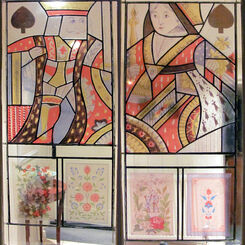
68: Playing cards in glass
My wife and I have recently commissioned a unique pair of stained glass windows for our home.
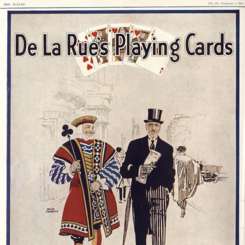
67: Adverts and related material after 1900
The final page of material relating to playing cards from British periodicals.

49: De La Rue in detail
A detailed presentation of the variants of De La Rue's standard cards.
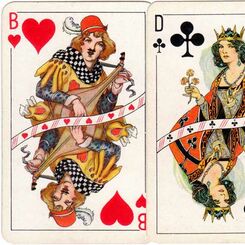
De la Rue for export
Non-standard playing cards produced by De la Rue & Co. (London), c.1930s
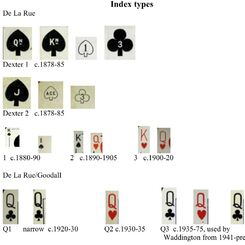
41: A Guide to Dating Playing Cards
Dating is a particularly tricky but very interesting problem to tackle and there are many pitfalls. ...

33: Functional Changes to Playing Cards
The emphasis throughout my collecting has been on the design of the courts cards, and it should be p...
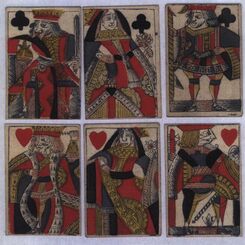
30: The Not-So-Minor Cardmakers of the 19th Century - Gibson, Hunt & Bancks
A preliminary look at the card-makers operating in the 19th century.
![28: How to Analyze and Differentiate Playing Card Plates (De La Rue, Waddington and the Berlin pattern [Französisches Bild]) 28: How to Analyze and Differentiate Playing Card Plates (De La Rue, Waddington and the Berlin pattern [Französisches Bild])](/core/cache-wopc-thumbs/var/www/wopc/production/www/images/contributors/kenlodge/4889-analyzing-playing-card-plates/JS_D1-D2-D3.4e1c4b9d.jpg)
28: How to Analyze and Differentiate Playing Card Plates (De La Rue, Waddington and the Berlin pattern [Französisches Bild])
My interest in postage stamp variants led me to apply the same principles to playing cards.
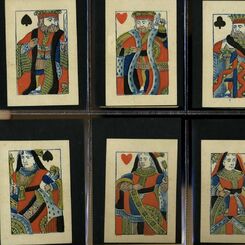
19: 19th Century Breaks with Tradition - Unusual versions of the Standard English Pattern
The centuries-long tradition of English court cards was subject to misinterpretation and in some cas...
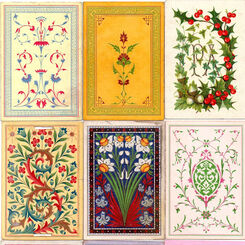
14: Back Designs
A few examples of the many interesting back designs.
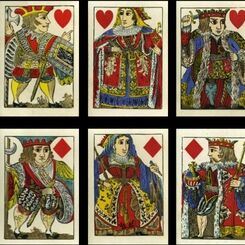
5: De La Rue
In December 1831 Thomas de la Rue was granted his patent for printing playing cards by letterpress.
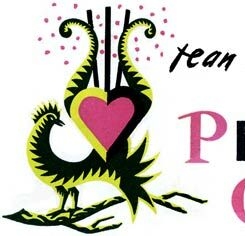
Jean Picart le Doux
Jean Picart le Doux playing cards, issued in 1957 to celebrate the company's 125th anniversary, feat...
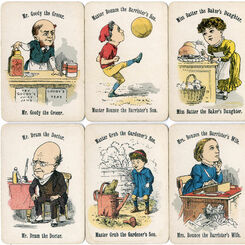
Cheery Families, c.1893
Cheery Families card game designed by Richard Doyle and printed by De La Rue & Co., Ltd, c.1893
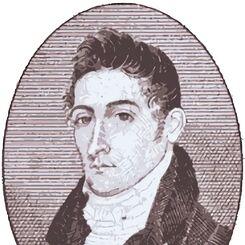
De La Rue
De La Rue introduced letter-press printing into playing card production and his patent was granted i...
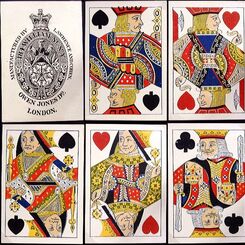
Lawrence & Cohen, New York
Lawrence & Cohen decided to hire Owen Jones, the English playing card designer who produced back des...
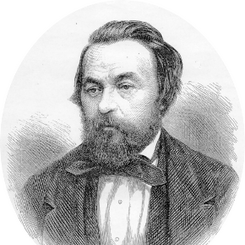
Owen Jones (1809-1874)
Owen Jones (1809-1874) was a Welsh architect and interior designer who designed the backs of playing...
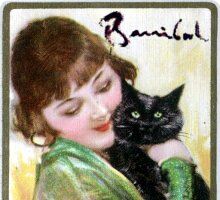
Barribal Series
William H. Barribal (1873 - 1956) was a London artist who created the Waddingtons 'Barribal' playing...
Most Popular
Our top articles from the past 60 days






































